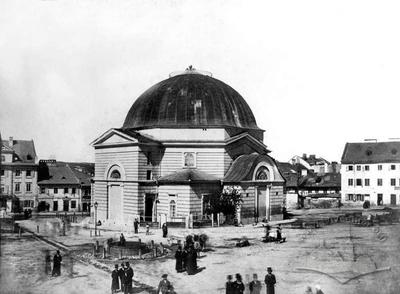
Synagogue of Progressive Movement on Staryi Rynok Square
- ID: 210
- Place: Lviv
- Date: 1863
The image shows the central entrance to the oldest park in Lviv (and Ukraine) from the side of the Galician Sejm (now Ivan Franko National University of Lviv), framed by two stone obelisks with images of lions' heads (not preserved). In the foreground is a flower garden, in the center of which was placed a vase by sculptor K. Tseptovsky with bas-reliefs (1839), which, according to Bertel Thorvaldsen's interpretation, depict “The Flow of Human Life” (the vase has now been moved to the current entrance to the main alley of the park). The flower garden is separated from the park by a semicircular hedge, which highlights a row of pedestals with busts of famous Lviv residents: publicist Jan Dobrzanski, theater director and director Jan-Nepomuk Kaminski, public figure and patron Prince Leon Sapieha, artist Artur Grottger, Father Samuel Glowinski, poet Count Leszek Dunin-Borkowski, erected in 1894-1896. The park has a long history. It was founded at the end of the 16th century by a Lviv patrician from the Scholz-Wolffovich family. In the 17th and 18th centuries, the park and the surrounding lands (known as the Rzeszów Field) were leased by the Jesuits. From that time on, it became known as the Jesuit Garden, and even after the order was dissolved, the name Jesuit or Poyezuit Garden was used until the beginning of the 20th century. After the Jesuits, the park became the property of the city and subsequently fell into disrepair, so in 1799 the city authorities sold it to entrepreneur Johann Gecht, who redesigned it in the regular French style and added new buildings. In the mid-19th century, the park again became the property of the city and was redesigned in the English style by city gardener Karl Bauer. Since then, its official name has been City Park. In 1916, the park was renamed Tadeusz Kościuszko Park, and in Soviet times it was renamed in honor of Ivan Franko. On the right, in the background, the Railway Directorate building is under construction. The prominent St. George's Cathedral (architect Bernard Meretyn, 1744-1761) is located on top of a hill 312 m above sea level.